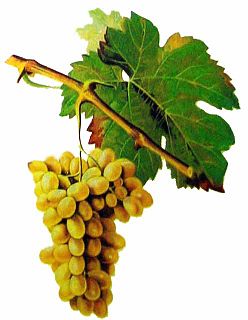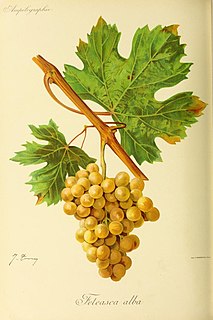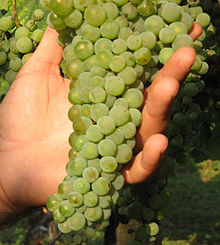
Aurore is a white complex hybrid grape variety produced by Albert Seibel and used for wine production mostly in the United States and Canada. Over a long lifetime Seibel produced many complex hybrid crosses of Vitis vinifera to American grapes. It is a cross of Seibel 788 and Seibel 29.

Pinot blanc is a white wine grape. It is a point genetic mutation of Pinot noir. Pinot noir is genetically unstable and will occasionally experience a point mutation in which a vine bears all black fruit except for one cane which produces white fruit.

Furmint is a white Hungarian wine grape variety that is most noted widely grown in the Tokaj-Hegyalja wine region where it is used to produce single-varietal dry wines as well as being the principal grape in the better known Tokaji dessert wines. It is also grown in the tiny Hungarian wine region of Somló. Furmint plays a similar role in the Slovakian wine region of Tokaj. It is also grown in Austria where it is known as Mosler. Smaller plantings are found in Slovenia where it is known as Šipon. The grape is also planted in Croatia where it is known as Moslavac. It is also found in Romania and in former republics of the Soviet Union. Furmint is a late ripening variety. For dry wines the harvest starts usually in September, however sweet wine specific harvest can start in the second half of October or even later, and is often affected by Botrytis.

Hárslevelű, also called Lipovina, Frunza de tei, Lindenblättriger and Feuille de Tilleul is a grape variety from the Pontian Balcanica branch of Vitis vinifera.

Melon de Bourgogne or Melon is a variety of white grape grown primarily in the Loire Valley region of France. It is also grown in North America. It is best known through its use in the white wine Muscadet.

Gouais blanc or Weißer Heunisch is a white grape variety that is seldom grown today but is important as the ancestor of many traditional French and German grape varieties. The name Gouais derives from the old French adjective ‘gou’, a term of derision befitting its traditional status as the grape of the peasants. Likewise, the German name Weißer Heunisch labels it as one the lesser, Hunnic grapes.

Trousseau Gris is a French grape variety made into white wine. It is occasionally found in eastern France and was once widely grown in California under the name Gray Riesling. In cool climates it can produce fresh aromatic wines. It needs gentle handling and careful winemaking to bring out its best.

Clairette blanche is a white wine grape variety most widely grown in the wine regions of Provence, Rhône and Languedoc in France. At the end of the 1990s, there were 3,000 hectares of Clairette blanche grown in France, although volumes are decreasing.
Cadarca or Kadarka or Gamza is a dark-skinned variety of grape used for red wine. It has a long history and is popular in Romanian wine|Romania]] and Bulgaria, where it is known as Гъмза Gamza. It used to be an important constituent of the Hungarian red cuvée Bull's Blood of Eger or Szekszárd, but has long been in decline in Hungarian plantations, to be replaced by Kékfrankos and Portugieser. It is also grown in most other central European and balkan countries where it is sometimes known as Cadarca or Skadarska.
Muscat Ottonel or Muskat-Ottonel is a white wine grape variety that is a member of the Muscat family of Vitis vinifera. It is most notable for its use in dessert wines from Austria, Bulgaria, Romania, Croatia and Serbia as well as dry wines from Alsace and Hungary. In Alsace, the varietal designation Muscat d'Alsace is allowed for the varieties Muscat Ottonel, Muscat blanc à petit grains and Muscat rose à petit grains blended in any combination -or not-, and blends between these are not allowed for most Alsace Grands Crus.

Aramon or Aramon noir is a variety of red wine grape grown primarily in Languedoc-Roussillon in southern France. Between the late 19th century and the 1960s, it was France's most grown grape variety, but plantings of Aramon have been in continuous decline since the mid-20th century. Aramon has also been grown in Algeria, Argentina and Chile but nowhere else did it ever reach the popularity it used to have in the south of France.

Not to be confused with Elbing, a city in Poland.
Räuschling is a white variety of grape used for wine. It is today almost only found in small amounts in German-speaking parts of Switzerland, where Räuschling can produce fruity, crisp white wines with good acidity. Räuschling has previously been much more common in Switzerland, Germany and Alsace. Before the widespread planting of Müller-Thurgau, Räuschling and Elbling were the most common grape varieties in Switzerland. German plantations were found in Franconia, Palatinate and Württemberg, as well as in Baden in medieval times. It is also thought to have been the grape variety of the early wines traded from Tramin, with Großer Traminer being one of its synonyms.

Fetească Albă is a Romanian - Moldovan white grape variety, mainly cultivated in Moldova and Romanian regions of Moldavia and Transylvania, as well as in the Hungarian wine region of Eger.
Dimyat is a white Bulgarian wine grape. It is one of Bulgaria's most widely planted white grape varieties, second only to Rkatsiteli. Wines made from this variety are noted for their perfume aromas. While some ampelographers believe that the variety is indigenous to Bulgaria, legends have developed around Dimiat being named after a town in the Nile Delta and was brought back to Europe by Crusaders in the Middle Ages.
Ezerjó is a white Hungarian wine grape grown primarily in the Mór region. Locally it is prized for it's very fruity nose and crisp, full bodied freshness.It is rare to find a bottle outside of Hungary as most is consumed by the local population and production is limited to certain small areas. This wine has a very long history including being a favorite with the royals of the Habsburg dynasty.
It is also used to make sweet dessert wines.
Green Hungarian, Butschera (Hungarian) or Putzscheere (German) is a white Hungarian wine grape. It is also found in California, but in recent years the grape has been declining in number of plantings.
Neuburger is a white Austrian wine grape. The grape is a crossing of Roter Veltliner and Sylvaner. As varietal, it generally produces full bodied wines.
Cascarolo bianco is a white Italian wine grape variety that is grown primarily in the Piedmont wine region of northwest Italy. The grape has a long history in the region and was noted in 1606 by Giovanni Battista Croce, vineyard owner and official jeweler to Charles Emmanuel I, Duke of Savoy, as growing in the hills around Torino and producing wine of high esteem. It was once thought that Cascarolo bianco was the same variety as the Hungarian wine grape Fehér Gohér but DNA profiling in the early 21st century determined that the two grapes are unrelated. Today ampelographers believe that the grape is an offspring of the Swiss wine grape Rèze with DNA evidence suggesting some relationship with another white Piedmontese grape, Erbaluce.
Luglienga is a white Italian wine and table grape variety that is grown across Europe. The grape has a long history of use, dating back to at least the 14th century in Piedmont but is today most seen a table grape that is occasionally used for home winemaking.















